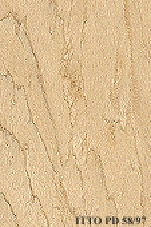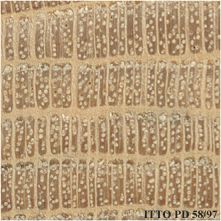
AJO-AJO (Gallesia integrifolia)
Trade Name
Ajo-ajo
Scientific Name
Gallesia integrifolia (Spreng.) Harms
Family
PHYTOLACCACEAE
Common Names
Palo Cebolla (Peru); Guararema (Brazil); Ajo ajo (Bolivia); Ajo (Peru); Pau D`Alho (Brazil); Garlic Wood
Scientific Name Synonyms
Thouinia integrifolia Spreng; Gallesia gorazema (Vell.) Moq.; Crataeva gorarema Vell.
Description Of The Tree
Botanical Description
It is a large tree, it attains heights from 15 to 30 m, with a diameter at breast height between 70 to 140 cm. Occasionally the diameter reaches 150 cm.
Natural Habitat
In Bolivia, Gallesia integrifolia is reported in subtropical montane forests, from 200 up to 1,300 m of altitude. It prefers dry lands.
Natural Distribution
In Brazil this species is reported to be common in the forests of the Parana basin.
Wood Identification
Anatomic Description Of Wood
Wood diffuse porous. Vessels solitary and in short radial multiples. Tangential diameter of vessel lumina 100 micras or less (very small). Tyloses common. Occasionally vessels per mm2 more than 20. Simple perforation plates. Vessel-ray pits similar to intervess Axial parenchyma apparent with the naked eye. Occasionally paratracheal axial parenchyma scanty and/or vasicentric. Axial parenchyma in thick bands. Prismatic crystals in non-chambered axial parenchyma cells. Styloids and/or elongate crystals in axial parench 4 to 10 rays per mm (medium). Rays of two distinct sizes. Occasionally larger rays width 0. 1 mm or more and 2 mm or more in height. Rays 1 to 2 seriate. Larger rays more than 4 seriate. Occasionally prismatic crystals in the ray cells. Heterogeneous rays and/or
-
 Wood Macro Photo Tangential Plane
Wood Macro Photo Tangential Plane
-
 Wood Micro Photo Of Transversal Section
Wood Micro Photo Of Transversal Section
Availability
Cites Status
Unrestricted
General Wood Description
Odor
It is reported to have a strong garlic-like smell.
Color
The sapwood is white yellowish, the heartwood gradually changes into dark yellow.
COLOR INDEX (1=Black, 7=Light yellow,white)
7
Grain
The grain is usually straight or interlocked.
Texture
The texture of the wood is fine.
Luster
It is reported to be moderate in luster.
Natural Durability
D. integrifolia is reported to be prone to biological attack.
Natural durability index (1= Very high durability, 7=Vey low durability)
5
Resistance To Impregnation
It has a high absorption of oil and water based preservative substances.
Wood Physical Properties
Basic Density or Specific Gravity (O.D. weight/vol. green) (g/cm³)
0.60
Air-dry Density (Weight and volume at 12%MC) (g/cm³)
0.66
Total shrinkage Tangential (Saturated to 0%MC) (%)
8.7
Total shrinkage Radial (Saturated to 0%MC) (%)
3.8
Drying Defects
Ease of Drying: It is reported to be easy to moderately difficult to dry. Drying Defects: It has a tendency to twist. In Peru risk of checking is reported.
Dimensional stability ratio (Total Tangential Shrinkage %/Total Radial Shrinkage %)
2.3
Wood Chemical Properties
Wood Mechanical Properties
Bending Strength (MOR),12%MC (kgf/cm²)
848
Compression parallel to fiber 12%MC (kgf/cm²)
440
Workability
Sawing
Sawing of this species is easy.
Planing
Planing operations are rather easy.
Turning
30
Sanding
Sanding of this species is reportedly easy.
Finishing
Finishing of this wood is rated as fair.
REFERENCED USES
End Uses Summary
HOUSING GENERAL, boards, shutter boards, TURNING, PACKING
General Housing
- 10 - Silica in Timbers
Boards
- 13 - Dry kiln schedules for commercial woods. Temperate and tropical. Section III. Latin American (Mexico, Central, and South America) Woods–Conventional Temperatures
Shutter Boards
- 20 - Prospect: The wood database
Turning
- 30 - Embassy of Honduras in Japan
Packing
- 45 - Recopilación y Análisis de Estudios Tecnológicos de Maderas Peruanas
Please Provide Information To View Producer Information